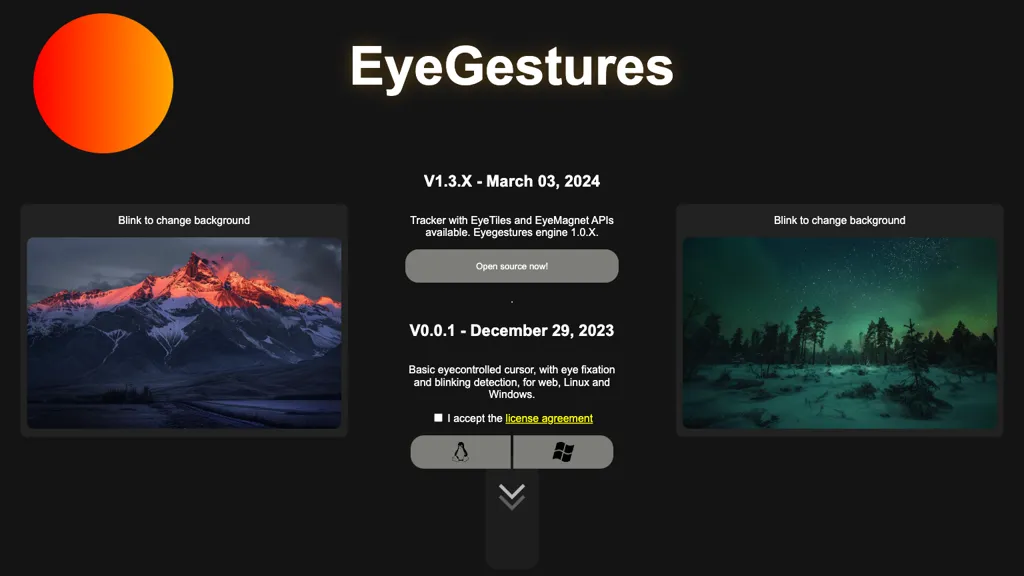Let’s find out more about EyeGestures
EyeGestures is open source software that is supposed to enable basic functionalities of eye-controlled cursor navigation, fixation, and blinking anywhere on web, Linux, and Windows platforms. APIs carried by the tool are Eyetiles, Eyemagnet, and their usage serves with extensive functionality for many types of applications. The versatility is enough to support non-profit operations, allowing it to perform with up to 50 eyetrackers deployed through three websites. Also, a pro version is available with advanced features for a fee per month, while for bigger organizational needs, enterprise solutions are offered.
Key Features & Benefits of EyeGestures
EyeGestures comes with a rich set of features and benefits that tremendously suit many different kinds of users. For example:
- Basic eye-controlled cursor navigation.
- Basic eye fixation detection.
- Blinking detection.
- Multi-platform: web, Linux, Windows.
- APIs available: Etiles, Eyemagnet.
These features afford a number of advantages, which include increased availability for the mobility impaired, better user game-playing experience, interactivity, and increased efficiency in research and design tasks by studying user attention patterns.
Applications and Usage of EyeGestures
EyeGestures can be used in the following ways to add value:
- Develop a UI that is operable so that even persons with mobility impairments are able to reach and manipulate web content using their eyes to navigate the cursor.
- Let games and other interactive applications be more exciting by providing blinking detection integration as an option for total hands-free gameplay.
- Enhance productivity doing research and design work based on eye fixation characteristics to understand better the pattern of user attention and optimize content layout for delivering high engagement.
How Does One Use EyeGestures
It is easy to use the EyeGestures application in just the following way:
- Download and install the EyeGestures free software from the website.
- Set up eyetracker configuration and system connection.
- Set up EyeGestures according to the user’s needs.
- Utilize available APIs (Eyetiles, Eyemagnet) to implement eye-tracking functionalities in your applications.
It is advisable to calibrate the eyetracker correctly and update the software every now and then for other top features and updates made.
How EyeGestures Works
EyeGestures works in conjunction with advanced algorithms and models for measuring eye movements to take them as commands to carry out actions. It continuously records the position of the eye, which can be used for cursor navigation, and looks for eye fixation and blinks to take actions. It is built into the underlying technology, compatible with several platforms, and ensures user consistency, user efficiency, and reliability.
Major Pros and Cons of EyeGestures
Pros:
- Better accessibility for users with mobility impairments.
- Support of multiple platforms (web, Linux, Windows).
- Open-source enabling customization and community contribution.
Cons:
- Only basic functionality in the free edition.
- Being based on the eyetracker hardware.
- High user learning curve – users require time to familiarize themselves with the interface.
EyeGestures FAQs
What platforms does EyeGestures support?
EyeGestures supports web, Linux, and Windows.
Is EyeGestures free of charge?
Yes, EyeGestures provides a free version with support of up to 50 eyetrackers deployable across 3 websites. It also offers a paid pro version that supports more features for a small monthly fee.
How do I integrate EyeGestures into my Application?
EyeGestures can be integrated into your app with the help of available APIs like Eyetiles and Eyemagnet.
What are the Key Benefits for Using EyeGestures?
The main benefits include: increased accessibility; great user experience within interactive games and applications; and more efficient research and design work.
Does EyeGestures have any drawbacks–or for that matter any limits?
Some of its cons include a lack of advanced features in the free version, a necessity for good quality eyetracker hardware, and a learning curve in using the software.










